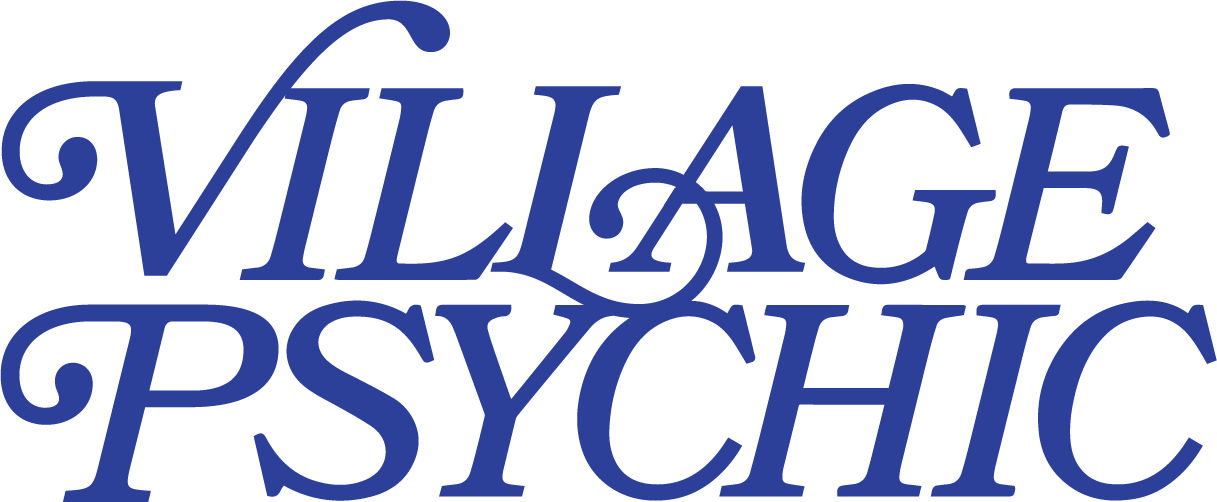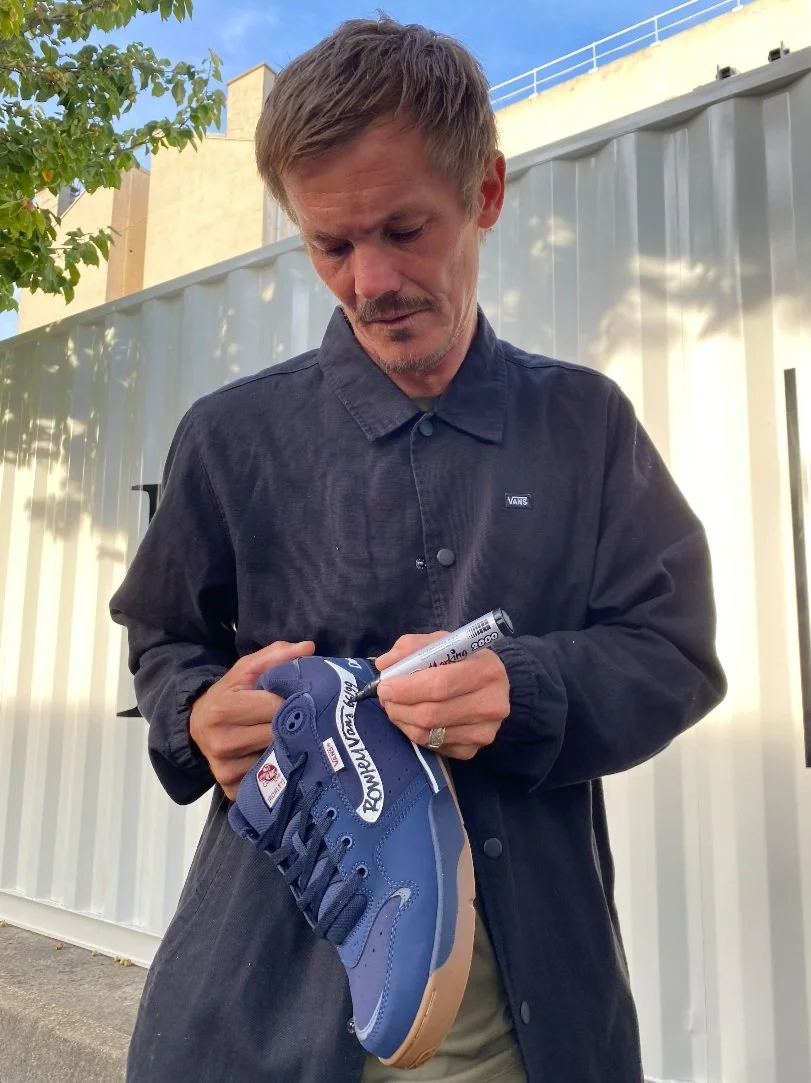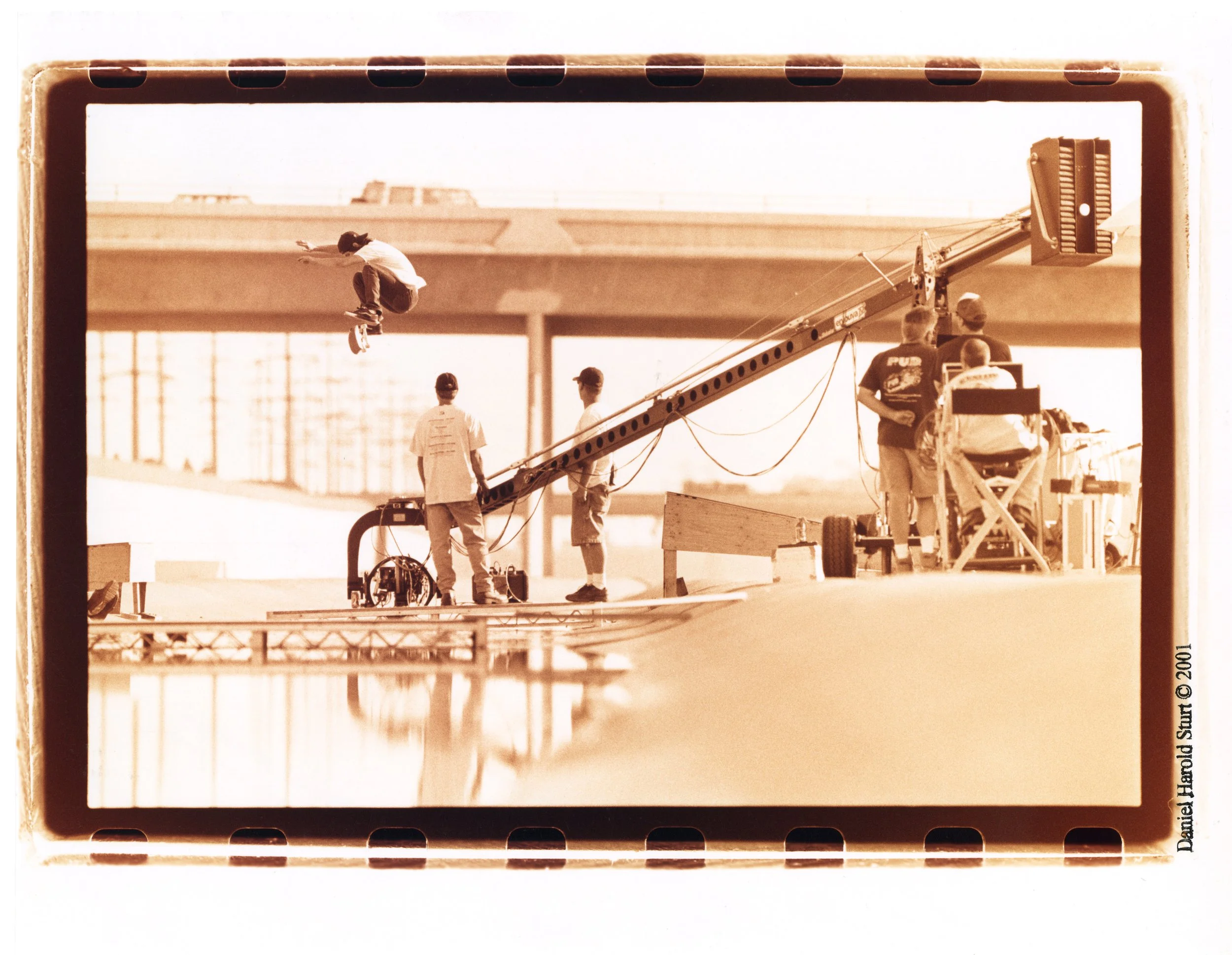Geoff Rowley and the Rowley XLT
Geoff signing a pair of he XLT in Paris.
First things first: how did the XLT come about? It’s quite a departure from your first shoe, the Rowley.
Well, the XLT was an evolution from my first shoe. My first shoe has all of the original Vans DNA, and once I had that one dialed in, I wanted a pair of shoes I could wear when I was kind of skating, or when I wasn't skating, and I wanted to support a skate brand when doing that. I didn't want to support running shoe companies. I don't run for a living, I skate. Skate shoes at that time were puffy and crazy, they were rock hard. The XLT was not rock hard. It's lightweight, it has good board feel, and it was designed to skate.
What was the reaction to the shoe at that time?
It was huge. The industry was growing fast and the Vans brand started growing like frickin’ hotcakes around the time of my first shoe. We needed that kind of evolution in order for Vans to grow at the rate of the industry. If I had done a second or third vulcainzed shoe at that time, it wouldn’t have evolved the brand like it did with the XLT. Evolution isn’t doing the same thing over and over, and for me, my first vulc shoe was perfect. I still love it. It’s what I choose to skate to this day.
Ad for Geoff’s first pro model.
Ad for the XLT.
Let’s talk about the differences in how the XLT was presented versus your first shoe.
It was a trip going from a vulc shoe, marketing the hell out it to skaters all through the mags and everything, then the next year, we're marketing to the same skaters, but we were also advertising it in Rolling Stone and other magazines, on MTV, and having the first commercial being directed by Anton Corbijn. We went from being within our own bubble to thinking much bigger. This shoe was the first of that for skateboarding.
We started doing billboards all over LA and Orange County, and that opened up a lot of people to seeing what we were doing at a new level. They were seeing a legitimate skate photograph, cropped the way it should be, on the side of a freeway. It was fucking gnarly, I was stoked. It felt like opening a page of Thrasher while you were driving, just on the side of the fucking road. It felt like I was kicking everyone else in the balls, you know?
That level of commercial production ended up in a 411 ad section. There really wasn’t a precedent for that.
Think of the pressure of that (laughs). I’m scared of the trick already, and then go into an actual film shoot with a crew of about 40 people, permits and everything, and to top it off the director is a person who’s made all the music videos with Nirvana, Depeche Mode, etc. You have to step up to that.
Was it challenging working with a director from outside of the world of skating?
I mean, it wasn't just me going out there and filming a trick for two hours. I had to go there two days before with the director to talk about movement I was going to go through and the day of the shoot. He doesn't understand skating, he's not a skateboarder. I have to explain to him how it would be best filmed, breaking down the sequence of the tricks – the start of someone taking off to where they are in the air, and where they land.
My standards at that age were too high, I just wanted to get gnarlier and gnarlier. Now I'm reasonable, and I get the same results. But at that time I was willing to do whatever it took if I could find the spot. So to have that opportunity at the river felt like a chance to evolve what I had been doing. I needed to do every single basic trick the best that I could ever do them, because I knew I was never going to be able to be in that realm ever again.
I grew up idolizing Daniel Harold Sturt. He’s an intense and difficult person, but he's the best. He would only document the gnarliest stuff, and he shot all the best - Danny Way, Tony Hawk, the water tower gap with Jeremy Wray. His standards were like my standards: If it's been done before, what the fuck are we doing here? I knew how I wanted to document my skating and the XLT was the start of an opportunity to.
Geoff as captured by the (seriously) legendary Daniel Harold Sturt.
What year did you get on Vans?
The end of 1998 I got on Vans, and then my first shoe came out towards the end of 99, and the next two shoes came out each year after that.
Was having creative liberty with designing these shoes part of the decision you went to Vans?
That's why I went to Vans, entirely. I was with a huge company before Vans, three times, four times bigger at that time, and I left and took a 50% pay cut. I went to Vans because I wanted to wear the shoes. The other company was having big growth issues, and I knew that they could go the wrong way. I had a signature shoe with that company that sold really well, but when the opportunity with Vans came along that would include freedom in designing my shoes to create the product I wanted for multiple years, I took that as almost an obligation.
Were people ready for a hybrid like the XLT – a more classic looking shoe with additional padding?
That shoe stood out like a frickin’ sore thumb in skate shops at the time. No one knew how to put it on the wall. Truthfully, there weren't really a lot of Vans on the wall at skate shops around then. But then, kids started going into the skate shops asking for that shoe and other Vans. Pros were too! (Two very prominent names redacted) literally bought them to try skating in them.
20 something years later, how do you feel about the return of the XLT with Dime?
It's flattering. It really is. You don’t know if you'll die tomorrow, so when things come full circle, it’s flattering. What Dime does is geared around skating, but these guys are fucking fun as all hell. I appreciate Vans as well for giving the shoe a life again. I think it is a good indicator of what's coming. They're listening to people and their athletes and that's fucking paramount. I'm thankful.
Geoff skating over the LA river for the XLT. Hopefully we see this again.
Last question: Will we see you skate over the LA river again to promote the shoe?
Set that up. I will backside 360 it.





